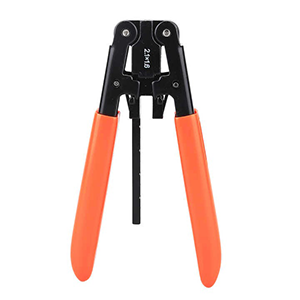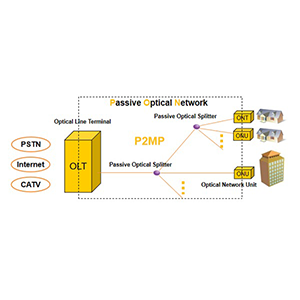Fiber optic splitters play an important role in optical communication networks. This article will compare the characteristics of PLC fiber optic splitters and FBT splitters. We will first define the basic structure and working principle of PLC splitters and FBT splitters, and explain their respective main features and advantages.
Next, we will deeply compare the differences between PLC fiber optic splitters and FBT splitters in terms of manufacturing process, optical splitting ratio, optical power loss, volume and weight, as well as cost and reliability. We will explain the impact of these differences on device performance and application. Finally, we will give suggestions for reasonable selection of PLC or FBT splitters based on the needs of different application scenarios.
Overview of PLC fiber optic splitters
Let me give you a brief introduction to the basic situation of PLC fiber optic splitters:
Definition of PLC fiber optic splitters:
- PLC (Planar Lightwave Circuit) splitter is an optical splitter based on planar optical waveguide technology
- It uses a specially designed planar optical waveguide structure to split and distribute the input optical signal
- PLC splitters usually have multiple output ports, which can split a single input light into multiple outputs
Working principle of PLC splitter:
- The optical signal at the input end will pass through the optical waveguide splitting structure inside the PLC splitter
- This structure can gradually split a single input light into multiple output optical signals
- This splitting process is achieved through optical components such as optical waveguide couplers
- Each output port can finally obtain a considerable optical power
Main features of PLC splitter:</h 3>
- Miniaturization and high integration: PLC splitters are manufactured using integrated chip technology, and are very small in size and weight
- Flexible splitting ratio: PLC splitters can provide a variety of splitting ratios such as 1xN to meet different application requirements
- Low optical loss: The optical signal attenuation of PLC splitters is usually less than 3.5dB, retaining most of the input power
- Excellent optical performance: PLC splitters have excellent optical parameter indicators such as insertion loss and uniformity
- High reliability: PLC splitters use mature manufacturing processes and have strong resistance to environmental interference
Compared with traditional fiber splitters, PLC splitters have been widely used in the field of optical communications due to their advantages such as small integration, low loss, and excellent optical performance, and have become the preferred splitter product for many key application scenarios.
Overview of FBT fiber splitter
Let me give you an overview of the basic situation of FBT (Fused Biconical Taper) fiber splitter:
Definition of FBT splitter:
- FBT splitter is an optical splitter based on fiber fused taper technology
- It is made of two single-mode optical fibers fused and tapered at high temperature
- The input light is split by adjusting the length of the fused zone and the taper angle
Working principle of FBT splitter:
- The optical signal at the input end will undergo optical coupling splitting after entering the fused zone
- The fused taper zone causes optical field coupling and interaction between optical fibers
- This coupling can split a single input light into multiple outputs
- Output The optical power distribution of the port is determined by the melting zone parameters
Main features of FBT splitter:
- Simple manufacturing process: The manufacturing process of FBT splitter is relatively simple and easy
- Low insertion loss characteristics: The optical insertion loss of FBT splitter is usually less than 1dB
- Low polarization dependence: FBT splitter is stable to light of different polarization states
- High reliability: FBT splitter adopts mature fiber melting technology and has strong anti-environmental interference ability
- Relatively low cost: The manufacturing cost of FBT splitter is lower than other splitters
Compared with PLC fiber splitter, FBT splitter has certain advantages in manufacturing process and cost. However, PLC splitter is usually more advantageous in terms of integration, loss, optical performance, etc. The two splitters have their own characteristics and play an important role in different application scenarios.
The main difference between PLC fiber splitter and FBT splitter
Let me compare the main differences between PLC fiber splitter and FBT splitter in detail for you:
Manufacturing process:
- PLC splitter is manufactured using planar optical waveguide integrated chip technology
- The process is relatively complex, but it can achieve high integration and miniaturization
- FBT splitter uses a relatively simple process of optical fiber fusion taper
- Process Simpler than PLC, but with weaker integration and miniaturization advantages
Optical splitting ratio:
- PLC splitters can provide a high splitting ratio of 1xN, up to 1×32
- The splitting ratio of FBT splitters is limited compared to PLC, generally between 1×2 and 1×16
- The high splitting ratio of PLC splitters is conducive to improving the utilization rate of optical signals
Optical power loss:
- The optical signal attenuation of the PLC splitter is usually less than 3.5dB
- The optical insertion loss of the FBT splitter is generally less than 1dB
- The higher loss of the PLC splitter may require more optical power compensation
Size and weight:
- PLC splitters use integrated chips, and their size and weight are very small
- FBT splitters use optical fiber fusion technology, and their overall size and weight are larger
- PLC splitters Miniaturization is conducive to system integration and deployment
Cost and reliability:
- The manufacturing cost of FBT splitters is relatively low
- The production cost of PLC splitters is higher, but the reliability is higher
- The cost and reliability differences will affect the selection of different application scenarios
In short, there are certain differences between PLC splitters and FBT splitters in terms of manufacturing process, optical splitting ratio, optical loss, volume weight, cost reliability, etc. The two splitters have their own advantages and disadvantages, and they need to be reasonably selected and applied according to specific application requirements.
Selection of PLC and FBT splitters in typical applications
Let me provide some suggestions on the selection of PLC and FBT fiber splitters in typical applications:
Access network applications:
- For fiber access networks, PLC splitters are recommended
- PLC splitters are more suitable for high splitting ratio and small integration
- Can efficiently distribute signals to multiple users through a single optical fiber
Data center applications:
- PLC splitters are also more suitable for optical interconnection networks within data centers
- PLC splitters have low loss characteristics that ensure high-speed optical transmission quality
- Its high integration is conducive to deployment in limited space
PON (passive optical network) applications:
- PLC splitter is the first choice for PON system
- PLC splitter’s high split ratio and low loss performance are more in line with PON network requirements
- It can efficiently complete PON optical distribution and support network construction and expansion
Sensing and testing applications:
- In the field of optical sensing and experimental testing, both splitters have applicable scenarios
- For scenarios that require miniaturization and high integration, PLC splitter can be preferred
- For applications that are more sensitive to cost, FBT splitter may be more suitable
In general, in most application scenarios, PLC fiber splitter is more suitable due to its excellent small integration, low loss, high split ratio and other characteristics. But for some applications that are more sensitive to cost, FBT splitter is also a good choice. At the same time, the applicability of the two splitters needs to be weighed according to specific application requirements and environmental conditions.
Summary
Both PLC fiber splitters and FBT splitters are key components for building high-performance optical communication networks, but they have some differences in technical indicators and application characteristics. Our company has long been focusing on the research and development and production of optical fiber communication technology, and has rich experience in the application of PLC and FBT splitters. We provide various high-performance PLC and FBT splitter products, and can provide the best choice according to your specific needs.
Whether your application scenario is access network, data center or other fields, our team of engineers will provide you with professional selection guidance and integration services to ensure that the selected splitter performs best in actual applications. Contact us now to learn more. We will do our best to provide you with the best products and solutions.
PLC Optical Circuit and FBT Optical Circuit FAQ
A Planar Lightwave Circuit (PLC) optical circuit is a type of integrated optical device that uses planar lightwave technology to split or combine optical signals with high precision and low loss.
An Fused Biconic Taper (FBT) optical circuit is a type of optical splitter that uses fused and tapered optical fibers to split or combine light signals. It is a traditional technology compared to PLC.
PLC optical circuits use a planar waveguide to route light signals. The waveguide is fabricated on a flat substrate, allowing precise control of light paths and efficient splitting or combining of signals.
FBT optical circuits work by fusing two or more optical fibers together and then stretching (tapering) them to achieve the desired splitting or combining ratio.
PLC optical circuits offer better uniformity, lower insertion loss, and more accurate splitting ratios. They are also more stable over a wide range of wavelengths and temperatures.
PLC circuits use integrated planar waveguides and are generally more precise and stable. FBT circuits use fused fiber technology and are simpler but may have higher insertion loss and less uniformity.
PLC optical circuits are used in high-performance telecommunications, data centers, and fiber-to-the-home (FTTH) networks due to their precision and low loss.
FBT optical circuits are commonly used in less demanding applications where cost is a primary concern, such as in some telecommunications and cable television networks.
PLC optical circuits typically have lower insertion loss (around 0.1 to 0.3 dB) compared to FBT optical circuits (around 0.5 to 1 dB) due to their more precise manufacturing processes.
Consider factors such as insertion loss, uniformity, wavelength range, cost, and application requirements. PLC circuits are preferred for high-performance applications, while FBT circuits may be chosen for cost-sensitive applications.



